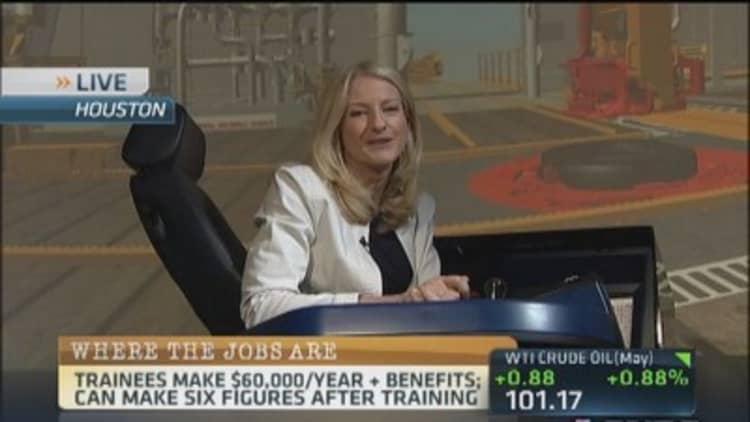
Twenty-four feet above the ground, 43-year-old Mark Evans is straddling an iron beam. Hooked into a safety harness, he inches his way across the beam as a safety instructor watches his progress from below.
Evans is undergoing height training at National Oilwell Varco's (NOV) technical college, a 34,000-square-foot facility in Houston. The aim of this exercise is to get service-technicians-in-training used to working on the derricks that frame the drilling equipment it makes and installs for its customers around the globe.
"When we looked around several years ago, trying to fill jobs one at a time, we recognized we just weren't getting the progress we needed, so we opened our first technical college," CEO Clay Williams said.
The Houston-based company now has six technical colleges around the world, including in Norway, the U.K. and Brazil. It is in the process of opening two more—in Shanghai and South Korea. The programs taught at the technical colleges are designed to fill gaps in a trainee's skills, so they can work in what has become a much more sophisticated industry over the last decade.
"It's very different today than when I joined the industry back in the 1980s," said Williams, who added that much of the change has been driven by the computer chip. "So software systems and controls systems, single board computers, and PLC (powerline communication) chips are embedded now in the equipment, and that has really changed the requirements for running this equipment."
The equipment Williams refers to are the land and offshore drilling systems that NOV's rig systems and aftermarkets unit sell and maintain. The systems cost anywhere from $10 million to $250 million. NOV's two other business are Wellbore Technologies, which assists clients in drilling their wells, and Production Solutions, which helps maintain a client's well after it is operational. The company plans to spin off its parts business this spring into a separate public company called NOW Inc.
Read MoreSolving manufacturers' jobs dilemma
About 400 or so service technicians will be trained at NOV's technical colleges this year. In the U.S., 50 percent are former military personnel, others come from community colleges, or with prior work experience in the automotive and aviation industries.
A trainee is in the classroom for six, nine or 12 months, taking courses on such subjects as hydraulics, electronics, mechanics and learning the software systems that run the rigs. After they complete their courses, the trainees are paired with a more experienced technician before they are sent out on their own to help build and service rigs.
"We can teach so much in the classroom," said instructor Paul Gunderson. "The theory we teach, we can even teach some of the 'hands on,' but we can't replace the actual 'hands on' of working on the rig. That is where the rubber meets the road."
For those who sign up to work at NOV as a service technician, a certain mindset is required. Williams said they need to be problem solvers, self-starters and calm in the face of chaos, which can ensue when a customer's rig is not working and the client is losing thousands, if not millions, of dollars a day until the problem is fixed.
"I like to be the guy on the spot," said Evans, who joined the training program in February after returning from a six-year stint in Afghanistan and Iraq as a service representative for Navistar. In both countries, he helped train U.S. military personnel on how to service and repair the armored vehicles made by Navistar.
Evans said concerns about the economy prompted him to apply for NOV's program.
Read MoreWicked winter puts big chill on job creation
"Reading a lot of the news about how the economy was going made me a little bit nervous about coming home, and trying to find something that was going to fit my needs," said Evans.
The unemployment rate has been improving over the last year, with the March figures showing the U.S. economy added 192,000 jobs and the unemployment rate at 6.7 percent. Still, skilled workers are tough to find. The Manufacturing Institute estimates some 600,000 skilled jobs are unfilled in the United States. This makes workers, like those trained by NOV, very attractive to other employers.
"It can be hard to keep them," said Williams. "One of the things we do is that we ask each of these new employees to enter into an agreement with us."
Read More
Williams estimates the company invests $70,000 on average for each trainee, so they are asked to sign a pact to stay on with the company for three years. If they leave early, they reimburse NOV for cost of their training.
If the trainees stay, they make $60,000 a year while taking classes, with full benefits. Once they start working, they can make in the six figures, said Williams.
The training does not come cheap. Williams estimates the company spends $50 million a year on the technical colleges, but it's a necessary investment. With 64,000 employees around the world, Williams said, NOV usually has 1,800 jobs in the U.S. open at any one time. He said being unable to fill those jobs has slowed its growth at times. It has also hurt its profit margins, as the firm has had to resort to paying overtime and outsourcing to keep up with demand.
Read MoreChart: What's the real unemployment rate?
Still, Williams believes that money spent on training is money well spent. In addition to getting trained workers, he said, NOV also wins if the trainee leaves because the worker will likely turn to NOV equipment at the new job.
—By CNBC's Mary Thompson.


